This article needs additional citations for verification .(July 2014) |

Uganda issued revenue stamps from around 1896 to the 1990s. There were numerous types of revenue stamps for a variety of taxes and fees. [1]
This article needs additional citations for verification .(July 2014) |

Uganda issued revenue stamps from around 1896 to the 1990s. There were numerous types of revenue stamps for a variety of taxes and fees. [1]
The British Vice Consul used Uganda's typeset postal stamps for tax purposes in 1896. These stamps did not bear any printed overprint, but the word Consular was handwritten in manuscript diagonally on the stamps. The 1898 stamps portraying Queen Victoria also exist with this manuscript overprint.
In around 1898, the same Queen Victoria stamps were issued with an overprint reading Inland Revenue for use as general-duty fiscal stamps. These were replaced by East Africa and Uganda stamps overprinted Uganda Revenue in around 1903. Similar overprints were later issued on stamps of Kenya and Uganda or Kenya, Uganda and Tanganyika. Similar overprints remained in use on nearly every definitive issue up to independence.
From 1932 to 1938, various Luwalo stamps were issued to pay a labour-related tax. No issued examples are known to have survived and the only copies are specimens in the Foreign and Commonwealth Office Collection of the British Library. These were replaced by poll tax stamps in 1940, which were Nyasaland key types showing King George VI. These remained in use until the 1950s.
In the 1930s, various Uganda revenues (previously overprinted on Kenya & Uganda or KUT stamps) were additionally overprinted to pay the motor driver's licence. From around 1946 to the mid-1950s, the 10/- value from the contemporary KUT George VI definitive issue were overprinted for use as immigration stamps. There are three types of the overprint.
Impressed duty stamps were introduced in Uganda in 1918 showing a design of a crown and leaves. These remained in use until the 1960s. [2]
Uganda became an independent sovereign state on 9 October 1962. Postage stamps were issued for the occasion, and they were also later overprinted for fiscal use. The Uganda Revenue overprints were also applied to some values of the 1965 birds definitive. A new type featuring a crowned crane was issued in 1966, and it was reissued with a different watermark in around 1970. General duty revenue stamps are no longer in use in Uganda.
Around 1965, large white labels were issued to pay the airport service charge. In November 1973, a set of two-part stamps was issued to pay the levy on commercial transactions. A self-adhesive stamps showing Entebbe International Airport was issued in the 1990s to pay the passenger service chargee. [2] The Uganda Revenue Authority issues various excise stamps to pay the tax on cigarettes up to this day.
Impressed duty stamps in vermilion showing a grey crowned crane were introduced in the 1970s and remain in use. [2]
A set of 10 stamps inscribed GRADUATED TAX BUGANDA and portraying King Mutesa II was prepared in early 1963. Only the 1/- value is known as an issued stamp. [2]

Revenue stamps of Malta were first issued in 1899, when the islands were a British colony. From that year to 1912, all revenue issues were postage stamps overprinted accordingly, that was either done locally or by De La Rue in London. Postage stamps also became valid for fiscal use in 1913, so no new revenues were issued until 1926–30, when a series of key type stamps depicting King George V were issued. These exist unappropriated for use as general-duty revenues, or with additional inscriptions indicating a specific use; Applications, Contracts, Registers or Stocks & Shares. The only other revenues after this series were £1 stamps depicting George VI and Elizabeth II. Postage stamps remained valid for fiscal use until at least the 1980s.
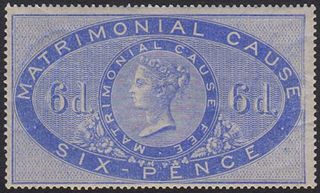
Revenue stamps of the United Kingdom refer to the various revenue or fiscal stamps, whether adhesive, directly embossed or otherwise, which were issued by and used in the Kingdom of England, the Kingdom of Great Britain, the United Kingdom of Great Britain and Ireland and the United Kingdom of Great Britain and Northern Ireland, from the late 17th century to the present day.

South Africa issued revenue stamps from 1910 to 2009. Apart from national issues various provinces of the country issued revenues from around 1855 to c. 1970.
The Australian state of Western Australia issued revenue stamps from 1881 to 1973. There were various types for different taxes.
The Australian state of Tasmania issued adhesive revenue stamps from 1863 to 1998, although impressed stamps had appeared briefly in the 1820s. There were general revenue and stamp duty issues, as well as a number of specific issues for various taxes.
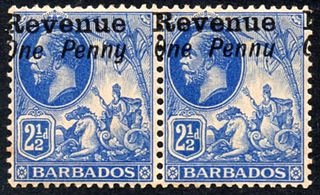
The island of Barbados first issued revenue stamps in 1916. There were various types of fiscal stamps for different taxes.

Libya first issued revenue stamps when it was an Italian colony in 1913 and continues to do so to this day. The provinces of Cyrenaica, Tripolitania and Fezzan as well as the municipality of Tripoli also had separate revenue issues until the 1950s and 1960s.

The South African Republic (ZAR), later known as Transvaal issued revenue stamps from 1875 to around 1950. There were a number of different stamps for several taxes.
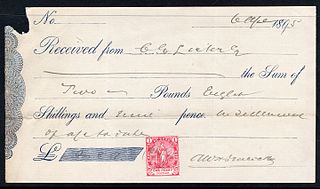
Cape of Good Hope issued revenue stamps from 1864 to 1961. There were a number of different stamps for several taxes.

New Zealand first issued revenue stamps on 1 January 1867 and their general use continued until the early 1950s. The only Revenue Stamp series still in use today is the Game Bird Habitat stamp which is used for payment of the Gun License for the duck shooting season which begins the first weekend of May. There were various types of fiscal stamps for different taxes.

Kenya, formerly known as British East Africa issued revenue stamps since 1891. There were numerous types of revenue stamps for a variety of taxes and fees. Also valid for fiscal use in Kenya were postage stamps issued by the following entities:

Nyasaland, now known as Malawi, first issued revenue stamps as British Central Africa in 1891 and continued to do so until the late 1980s.

Hong Kong issued revenue stamps from 1867 to the 1990s, both when it was a British colony as well as when it was under Japanese occupation.
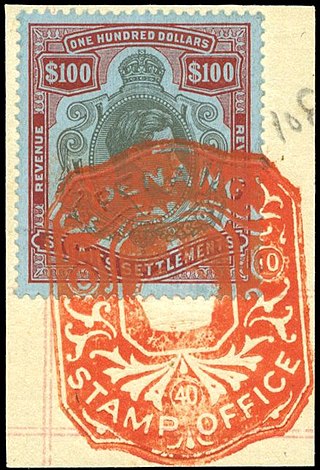
Malaysia first issued revenue stamps as the Straits Settlements in 1863, and continues to do so to this day. Over the years, a number of entities in modern Malaysia have issued revenue stamps.

Over the years various Malay States issued their own revenue stamps. Now most states use Malaysian revenue stamps, except for Singapore which is independent and no longer uses revenue stamps.
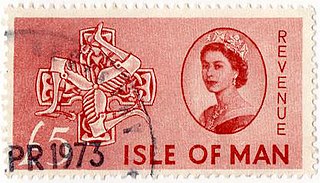
Revenue stamps of the Isle of Man refer to the adhesive revenue or fiscal stamps which were issued by the British Crown dependency of the Isle of Man between 1889 and 1976. British key type revenue stamps with an appropriate inscription were issued on the island until 1966, when revenue stamps showing various scenes and symbols of the island began to be issued. The last set of stamps was issued in 1976. From around 1920 to the 1970s, hundreds of contribution stamps were issued for National Insurance and related schemes.
Revenue stamps of Fiji were first issued in 1871 or 1872, when the Fiji islands were an independent kingdom. The first revenue stamps consisted of postage stamps overprinted with the letter D.
Revenue stamps of Seychelles were first issued in 1893, when the islands were a dependency of the British Crown Colony of Mauritius. The first stamps were Mauritius Internal Revenue stamps depicting Queen Victoria overprinted for use in Seychelles, and Bill stamps were also similarly overprinted. Postage stamps depicting Victoria or Edward VII were overprinted for fiscal use at various points between 1894 and 1904, while surcharges on Bill stamps were made in around 1897–98.

Revenue stamps of Hawaii were first issued in late 1876 by the Kingdom of Hawaii to pay taxes according to the Stamp Duty Act of 1876, although embossed revenue stamps had been introduced decades earlier in around 1845. The stamps issued in 1876–79 were used for over three decades, remaining in use during the Provisional Government, the Republic and after Hawaii became a U.S. Territory. Some changes were made along the years: from rouletted to perforated, and some new values, colours, designs and overprints were added. Some postage stamps were briefly valid for fiscal use in 1886–88 to pay for a tax on opium imports, and a stamp in a new design was issued for customs duties in 1897. A liquor stamp was issued in 1905.
Few revenue stamps of Nigeria and its predecessor states have been issued, since most of the time dual-purpose postage and revenue stamps were used for fiscal purposes. The first revenue-only stamps were consular stamps of the Niger Coast Protectorate and the Southern Nigeria Protectorate, which were created by overprinting postage stamps in 1898 and 1902 respectively. The Northern Nigeria Protectorate did not issue any specific revenue stamps, but a £25 stamp of 1904 could not be used for postal purposes due to its extremely high face value.